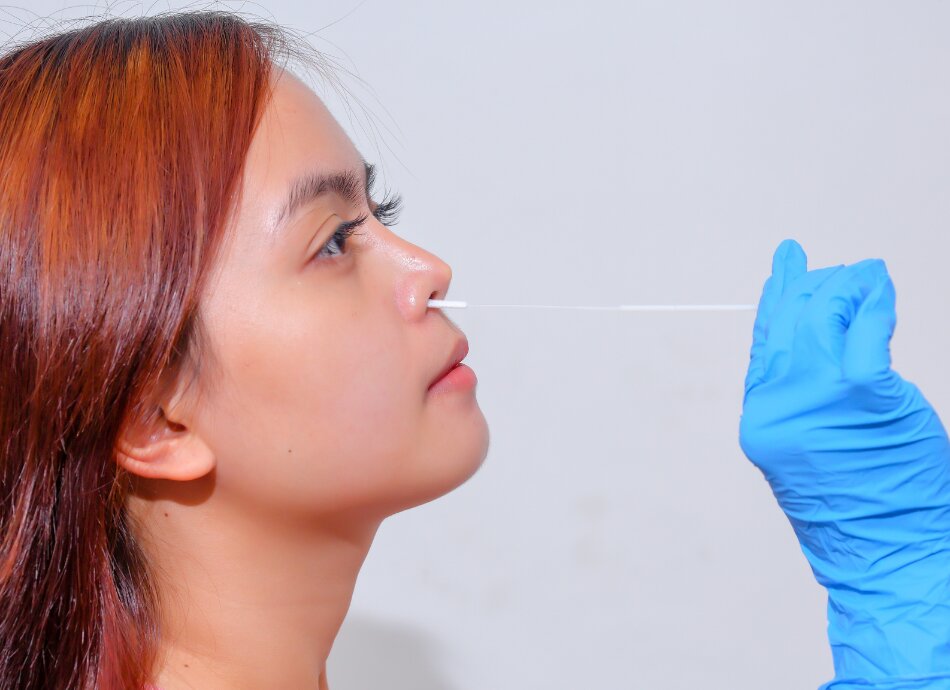Secretions from the back of your nose and upper throat are collected using a swab. The secretions are sent to a laboratory where they are grown. This makes it easier to identify which viruses, bacteria or fungi are present. The results are sent back to your doctor who will use them to help diagnose what germs could be causing your symptoms.
Low or no data? Visit zero.govt.nz, scroll down the page then click on our logo to return to our site and browse for free.
Nasal swab test
Also known as a nasopharyngeal swab or aspirate, and pertussis testing
Key points about a nasal swab test
- A nasal (or nasopharyngeal) swab is used to diagnose upper respiratory tract infections, such as whooping cough and COVID-19.
- It is a quick test that may feel a little uncomfortable but is not painful.
- A small soft-tipped swab is inserted into one or both nostrils and wiped around the inside of the nostril to collect mucous secretions.
- The secretions are then tested for presence of a virus, bacteria or fungi.

A small, soft-tipped swab will be inserted into one or both of your nostrils and twirled a few times until it is covered in secretions. Only a single swab is taken for COVID-19 testing.
The swab will be inserted quite a way in to get to the area that will give the best result. This may be a little uncomfortable but should not be painful.
Note that occasionally a suction device may also be used to gently remove the secretions. This is known as a nasal (or nasopharyngeal) aspirate.
Although a nasal swab is the preferred option for COVID-19 diagnosis, sometimes a throat swab is used.
Video: Collection of Nasopharyngeal Specimens with the Swab Technique | NEJM
This video may take a few moments to load.
(NEJMvideo, US, 2009)
If your doctor uses the nasal aspiration method, a small tube will be inserted into your nostril. This tube is connected to a suction device, which gently removes secretions from your nose. This will be repeated on the other nostril.
The following links provide further information about nasal swab testing. Be aware that websites from other countries may have information that differs from New Zealand recommendations.
Updated advice for health professionals – novel coronavirus (COVID-19)(external link) Health New Zealand | Te Whatu Ora
Nasopharyngeal aspirate(external link) Medline Plus, US
Pertussis – laboratory testing(external link) Centers for Disease Control and Prevention, US
Best practices for health care professionals on the use of polymerase chain reaction (PCR) for diagnosing pertussis(external link) Centers for Disease Control and Prevention, US
Nasopharyngeal swab
A nasopharyngeal swab is used to sample secretions from the back of the nose and upper throat to help identify what pathogens are present that could be causing symptoms or disease.
A nasopharyngeal swab or aspirate is needed for Polymerase Chain Reaction (PCR) testing, one of the best ways to diagnose pertussis. or COVID 19. PCR is "a molecular technique used to detect DNA sequences of the bacteria or virus being tested for".
- Specimens for PCR testing should be obtained by aspiration or swabbing the posterior nasopharynx.
- Throat swabs and anterior nasal swabs are not suitable as they have much lower rates of DNA recovery.
- PCR testing needs to be done within the first 2–4 weeks. After this time, there is less bacterial or viral DNA present and a higher rate of false-negative results.
- It is important the test is performed correctly and the person taking the sample wears appropriate safety gear to reduce their exposure.
- This includes safety glasses, paper mask and gloves.
- Not all community labs will collect a nasopharyngeal swab. Check your local services.
Video: Collection of Nasopharyngeal Specimens with the Swab Technique | NEJM
This video may take a few moments to load.
(NEJMvideo, US, 2009)
Clinical resources
Nasopharyngeal aspirate handout(external link) Medline Plus, US
Surveillance manual's chapter on pertussis – laboratory testing(external link) Centers for Disease Control and Prevention, US
Best practices for health care professionals on the use of Polymerase Chain Reaction (PCR) for diagnosing pertussis(external link) Centers for Disease Control and Prevention, US
Credits: Healthify editorial team. Healthify is brought to you by Health Navigator Charitable Trust.
Reviewed by: Gwenda Lawrence, medical laboratory scientist, Auckland
Last reviewed:
Page last updated:





